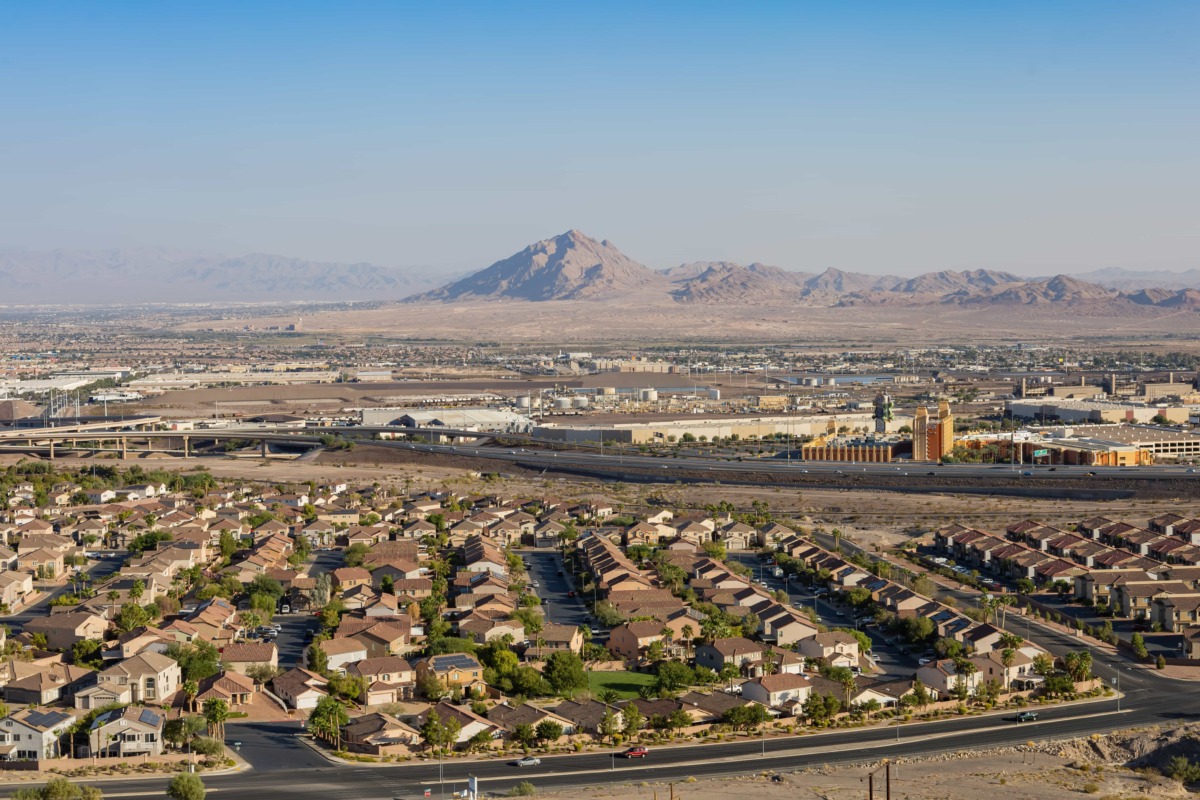
LAS VEGAS, NEVADA - AUGUST 08: An aerial view of a housing development on August 08, 2025 in Las Vegas, Nevada. (Justin Sullivan/Getty Images)
Leisure and hospitality workers in Nevada struggle to make ends meet.
With average rentals climbing to around $2,000 a month—and landlords requiring applicants’ earnings to exceed three times the rent—Nevada is having a hard time providing housing to its largest population of workers.
For the state’s biggest industry—the 24% of workers in leisure and hospitality— some struggle to live making $631 a week, the lowest hourly wages in Nevada. According to the National Low Income Housing Coalition, the average hospitality worker would need to work 2.7 jobs to cover a standard two-bedroom rental.
Meanwhile, some residents’ dreams of owning homes are stifled by mounting rent and other bills. For others, rising rent prevents them from leaving the nest, like 27-year-old DeSean Brewer.
A marketing manager who mainly does contract work at nightlife venues including Secrets Lounge and Restaurant located in central Las Vegas, Brewer wants to move out of his mother’s home. High rent prices keep him there. He’s just one of 371,000 hospitality workers in Nevada, and he feels priced out of the volatile housing market.
“I don’t feel comfortable with getting an apartment with where I am now, based on how things are not really consistent with workflow,” he said. “In the service industry, at any time, your role can go away, or that establishment can close down and I noticed that the rent is going up for business owners.”
Housing affordability is a crisis in Nevada, with stagnant wages and the highest unemployment in the nation, which can contribute to homelessness. A report by the nonpartisan Guinn Center for Policy Priorities released early this year suggests that rents have skyrocketed as a result of low inventory and high demand.
The situation is even more challenging amid Nevada’s severe shortage of low-income homes.
With a fragile economy that deeply relies on tourism and excess spending, an affordable housing market is crucial, Brewer said. This echoes loudly as consumer spending reportedly declines in Clark County.
Despite the circumstances, Brewer is optimistic about his future housing options, citing that new job opportunities could make the difference between staying with his mother or moving out on his own. His ideal home would be located in Henderson and cost him no more than $1,500 for all of the expenses, utilities, and amenities associated with renting.
“When everything is a la carte, I don’t think it’s [affordable],” he said. “I would like something that has some type of bundle package…to ease the overall costs.”
Housing solutions for some
In an effort to alleviate the crisis, policymakers passed Assembly Bill 540, dubbed the governor’s housing bill. It aims to increase the housing supply and puts resources toward middle-income earners making up to 150% of the area median income (AMI) with an $133 million “attainable housing fund.”
In 2023, Nevada’s most populous region, Clark County, had an AMI of $75,103 a year. According to that number, under the governor’s housing bill, which redefines affordable housing, resources could be allocated to individuals making nearly $200,000 a year.
That may not immediately help Brewer—nor address the state’s severe shortage of extremely low-income housing—but the changes could put hospitality worker Tishara Walker, 33, who rents, in a better position to buy a home.
Buying a house, for Walker, means living in a place she likes, not just one that’s affordable. She mentioned that even though homes are cheaper in North Las Vegas, she wants to avoid being stuck in the area where she grew up.
“Things just need to become more affordable,” she said. “It just seems like it’s becoming more and more difficult for people to keep up.”
To meet the high cost of living, Walker, who said she likes “nice, decent homes,” is increasing her income through entrepreneurship, running a credit repair business. At the same time, she works as a cocktail waitress at the Bellagio Hotel and Casino on the Las Vegas Strip to support herself and her three children.
Walker said a simple solution to housing costs disparities is increased wages. She said she makes enough to cover her rent, but this year she’s feeling more pressure.
Ideally, she’d buy a home for around $200,000 to $300,000 in the Southwest region. According to the real estate website Redfin, the region’s sale price of homes, including condos, is 1.1% higher than last year, with a median sale price of $485,000.
“Rent has increased, gas has increased, everything else around us is increasing,” Walker said. “But you’re keeping the same workers on the same pay, or you’re giving a small promotion of 50 cents to $1.”
Future policy opportunities
Policymakers made little progress toward affordability, despite years of necessity, even under a four-year Democratic rule at the statehouse from 2019 through 2022. But according to a local housing advocate, policymakers recently made some notable strides.
Maurice Page, executive director of the Nevada Housing Coalition, which advocates for affordable housing, said that despite a lack of policy focused on the state’s most critical housing gaps, the last legislative session was the most successful he’s seen. He’s been a housing advocate for Nevadans for 16 years.
“Housing was at the forefront of many areas,” Page said. “We had good policies that were created … positioning Nevada in a good space right now.”
He stated that the legislation introduced was mainly for affordable housing or tenant protections, with about 40% of them passing including Assembly Bill 475, which puts $21 million towards eviction diversion programs for Clark County, the City of Reno, and the Nevada Rural Housing Authority. Then Assembly Bill 366 puts $25 million towards permanent supportive housing.
But for Page, there’s a lot more to do to improve housing access in Nevada, such as reintroducing Senate Bill 391 during the 2027 Legislature. The bill—sponsored by Democratic Assemblywoman Dina Neal—would have limited corporations from buying more than 100 residential units per year and increased county regulations.
It passed the state Senate with amendments but died in the Assembly without a reading.
Page said the logistics of the bill are what killed it, though he believes the intentions behind the proposal could slow down price hikes in the housing market. However, he pointed to miseducation and biases as another issue to address to improve housing affordability.
“We have to throw our personal biases out the window to be able to overcome the issues at hand,” he said. “Housing affects everything. And we need to all come together to find the correct solutions.”

Two bills seek to address growing issue of home insurance cancellations over wildfire risk
By April Corbin Girnus and Jeniffer Solis, Nevada Current Thousands of homeowners in Nevada have seen their insurance policies canceled or...

The 27 most expensive homes for sale in Las Vegas right now
Stacker compiled a list of the most expensive homes in Las Vegas listed for sale on realtor.com. Homes are ranked by price with ties broken by price...

Democrats tee up eviction reform Lombardo vetoed two years ago
BY MICHAEL LYLE - NEVADA CURRENT Upon returning home to Las Vegas from a trip from Los Angeles, Lousetta Keyes found a 7-day “pay rent or quit”...












